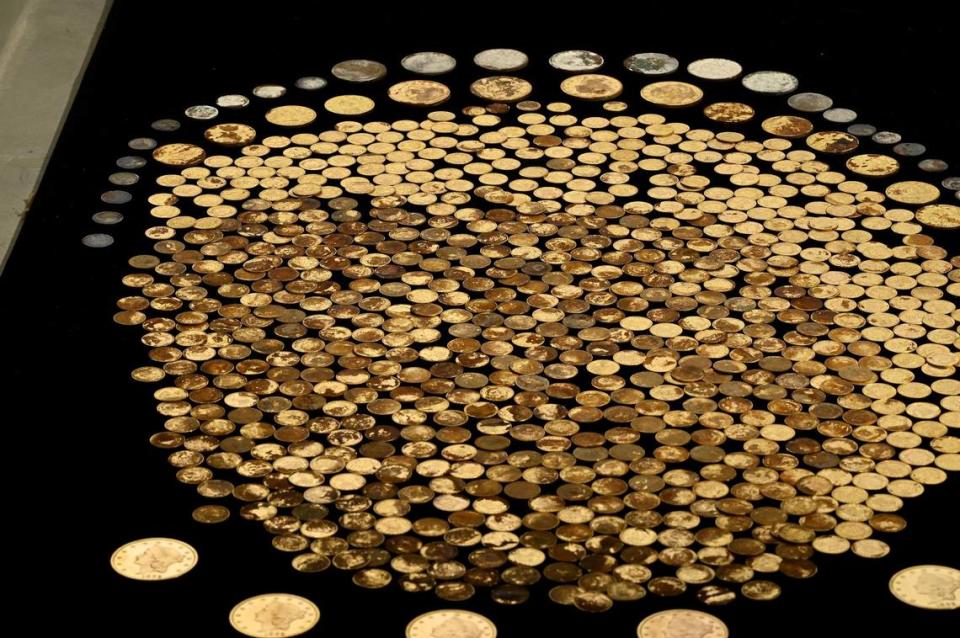‘Things that only happen in dreams.’ Ky. man who found trove of gold coins shares story on KET
A man who found a cache of more than 700 rare gold and silver coins from the Civil War era in a Kentucky cornfield last year is sharing his story for the first time on KET.
A special episode of “Kentucky Life,” scheduled to air on KET for the first time at 8 p.m. May 11, takes a closer look at what has been called the Great Kentucky Hoard.
“I initially found the 1856 Seated Liberty Half Dollar probably 20 to 30 feet from where the hoard was located,” KET says the farmer told “Kentucky Life.” “I would have never believed what came next. Things that only happen in dreams. When I continued walking and saw the glint of gold — a thick reeded edge.
“When I pulled the coin from the ground, I was astonished when I realized I was holding a $20 Double Eagle from the 1860s. After I flipped the first clump of dirt over the next 45 minutes to an hour, the coins kept coming. I knew it was hundreds.”
The identity of the man who unearthed the coins has not been publicly divulged, nor has the location of his find.
Chip Polston, host and producer of “Kentucky Life,” said in an interview he felt it was important for his show to respect that.
“I completely understand why he wants to remain anonymous,” said Polston, who for years was the face of the Kentucky Lottery and said he knows the pressures that come with sudden wealth. “He doesn’t want to open up his front blinds some Saturday morning and there be 70 people with shovels and metal detectors. ...What would happen to his farm?
“It could be a huge mess for him.”

Jeff Garrett, a Lexington-based expert on rare coins, worked with the man who found the treasure to help bring the Great Kentucky Hoard to retailer GovMint.com for sale. The trove included $1, $10 and $20 gold coins, including rare 1863 Double Eagles.
Polston said he initially reached out to Garrett, who granted an interview in which he told how the farmer first sent him a grainy photo of a coin, and how they arranged to fly with the multi-million-dollar collection to Florida, where the coins were prepared for sale last year.
Garrett, who founded Mid-American Rare Coin Galleries in Lexington, helped Polston connect with the farmer.
Polston said he sent the farmer six written questions, not knowing if he’d get an answer.
After a few months of going “back and forth,” Polston said the farmer ultimately sent him “three single-spaced typewritten pages” in which he told “how the whole thing came together.”
“It’s a remarkable story,” Polston said.
He said the man told him he was walking in a newly-plowed field when the sun hit a coin in the dirt just right.
“He caught a glimpse of something gold and metallic,” Polston said.
After finding the first coin or two, Polston said the farmer pulled out his phone and began filming as he discovered more and more coins.
“He’s digging through the ground and these gold coins are literally spilling out,” Polston said of the footage.
He said the farmer “has very vivid memories of he and his grandmother walking creek beds” in search of arrowheads and other interesting things.
“This is something he had been doing as a kid,” Polston said.
Polston said that when the story of the treasure broke last July, he knew “it was perfect for our show.”
“There was just so much imagination that was captured by this story,” he said. “I just knew we had to try to tell it.”
Polston said the Kentucky Educational Television Facebook page will ask viewers to weigh in on how they think the gold came to be buried in the ground in the first place.
He said “Kentucky Life” interviewed five people for the episode, and “every single one of them has a different answer.”
The dates on the coins, between 1840 and 1863, coincide with the time when raiders led by Confederate Gen. John Hunt Morgan were active in Kentucky, Ohio and Indiana.
One theory, Polston said, is that a wealthy landowner buried his coins to keep them safe.
Or maybe, he said, the money was stolen and buried by someone who intended to come back and get it but never did.
Polston said the man who found the coins sold most of them but kept a few, including one with the faint imprint of a burlap bag.
After it airs Saturday, Polston said the episode of “Kentucky Life” will be available on YouTube and will be shown again on KET, KET2 and KETKY multiple times over the next week.


